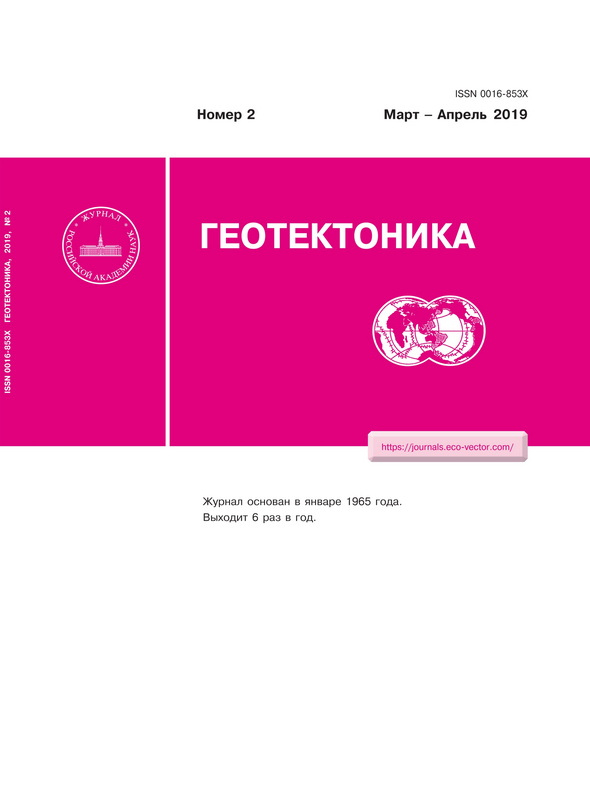№ 2 (2019)
- Год: 2019
- Статей: 4
- URL: https://journals.eco-vector.com/0016-853X/issue/view/734
- DOI: https://doi.org/10.31857/S0016-853X20192
Статьи
От Кенорлэнда до современных континентов: тектоника и металлогения
Аннотация
В тектонической истории Земли выделено три этапа: (1) нуклеарный — от возникновения протократонов до их сбора в суперконтинент Кенорлэнд (2.7–2.5 млрд лет), (2) кратонизации — от распада Кенорлэнда (2.45 млрд лет) до сбора Колумбии (1.85 млрд лет) и ее преобразования в Родинию (1.0–0.72 млрд лет), тектоники плит современного типа — от распада Родинии 720 млн лет до настоящего времени. Анализ перегруппировки во времени архейских гранулит-гнейсовых террейнов, соответствующих континентальным литосферным килям, позволяет выделить пять групп протократонов (Нена, Ур, Конго-Сахара, НАзия и Атлантика), остававшихся близко расположенными на протяжении длительного времени. Континентальная кора испытала вращение против часовой стрелки после распада протократона Кенорлэнд. НАзия и Атлантика характеризуются наименьшими поворотами и дрейфом относительно Нены, которая была повернута на 180°, наибольшие повороты характерны для Конго-Сахара, Ур и Калахари. С процессами сбора и распада суперконтинентов четко коррелирует смена преобладающих типов месторождений цветных, благородных, черных металлов и алмазов.
 3-32
3-32


Распределение кайнозойских металлоносных угленосных месторождений в Зейско-Буреинском осадочном бассейне (Восточная Сибирь): тектоническая реконструкция и палеогеографический анализ
Аннотация
Проанализировано распределение минерализации благородных металлов, редких металлов и редкоземельных элементов в палеоценовых и нижне-среднемиоценовых углях Зейско-Буреинского бассейна. Выполнена реконструкция формирования бассейна в мезозое и кайнозое с детальным палеогеографическим анализом кайнозойских угленосных толщ с позиций геодинамических особенностей развития сопряженных территорий. Детально рассмотрены геологические события на рубеже мела и палеогена. Проведен комплексный анализ металлоносности обрамления бассейна. Показано, что условия миграции и локализации микроэлементов возникали преимущественно в процессе геодинамики региона, развивавшейся на северо-западном фланге Зейско-Буреинского бассейна в обстановке статичного состояния орогенов в палеоцене—миоцене, и активного расширения области седиментации.
Миграция микроэлементов происходила, захватывая денудационные равнины, в устойчивых процессах торфонакопления и локализации полезных компонентов в сопряженных с равнинами водотоках. Высокая динамическая активность района на юго-восточной окраине Зейско-Буреинского бассейна обусловила контрастные формы сопряжения в системе впадина—поднятие и неравномерный характер локализации микроэлементов. Установлено, что золото присутствует по всему разрезу палеоценовых и нижне-среднемиоценовых угленосных отложений Сергеевского, Ерковецкого и Райчихинского месторождений. Угли Сергеевского месторождения обогащены бериллием, скандием, ванадием, галлием, рубидием, ниобием, танталом, иттрием и редкоземельными элементами.
 33-45
33-45


Реликт мезоархейской океанической литосферы в структуре Беломорской провинции Фенноскандинавского щита
Аннотация
В статье рассматривается геологическое строение метаморфизованной базит-гипербазитовой ассоциации Центрально-Беломорского пояса Беломорской провинции Фенноскандинавского щита. Приведены результаты изотопно-геохронологического датирования и петро-геохимических исследований. Сделан вывод, что протолит, возраст которого оценивается в ~ 2.9–3.1 млрд лет и в котором произошли два значительных структурно-метаморфических преобразования 2.87 и 1.87 млрд лет, является одним из древнейших комплексов Беломорской провинции. Показано, что базит-гипербазитовая ассоциация обнаруживает петро-геохимическую когерентность метабазитов и метагипербазитов, указывающую на генетическое единство их протолитов, т. е. мантийного перидотитового источника и продуктов его плавления — вулкано-плутонической серии основных пород, что позволяет рассматривать ее как фрагмент мезоархейской океанической литосферы. Петрологическое моделирование протолитов метабазит-гипербазитовой ассоциации показало, что первичные расплавы формировались в поле гранатового лерцолита при давлении 3.5–3.8 ГПа и потенциальной мантийной температуре верхней мантии 1520–1550 °С. Это позволяет оценить мощность изученного фрагмента архейской океанической коры в ~ 25–30 км. Геохимические данные подтверждают, что рассматриваемая ассоциация образовалась на начальной стадии инициации субдукции, маркируя старт процессов формирования древнего фрагмента континентальной коры Беломорской провинции.
 46-71
46-71


Формирование тылового склона островной дуги Каледонид хребта Чингиз на востоке Казахстана
Аннотация
Рассмотрен процесс формирования островодужного тылового склона на примере верхнекембрийско-среднеордовикской дуги, известной в хребте Чингиз на востоке Казахстана. Показано его возникновение на исходе вулканической деятельности в островодужном сооружении, начиная с конца раннего аренига (с конца флоского века раннего ордовика), появлением тефротурбидитов.
После прекращения вулканизма в накопившемся в среднем ордовике осадочном разрезе склона выделены два седиментационных цикла: трансгрессивный, когда островная дуга испытывала погружение, и регрессивный, когда в начале лланвирнского (дарривильского) века Чингизская дуга стала воздыматься. Осадконакопление неоднократно сопровождалось оползневыми процессами, которые завершились в середине лланвирна (дарривилия) срывом тектоно-гравитационной пластины, сложенной верхнекембрийскими вулканитами с известняками в подошве, в результате чего перед аллохтонной массой образовался свал грубообломочных пород и дальнейшая седиментация на тыловом склоне прекратилась.
 72-80
72-80











